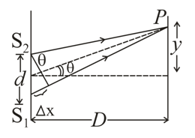Interference of Light
Interference of Light: Overview
This topic covers concepts, such as, Interference of Light Waves, Intensity of Interference Pattern, Use of Lloyd's Mirror in Coherent Light Wave Production & Optical Path in a Medium etc.
Important Questions on Interference of Light
In Young’s double slit experiment, the two slits 0.15 mm apart are illuminated by monochromic light of wavelength 450 nm. The screen is 1.0 m away from the slits.
(a) Find the distance of the second (i) bright fringe, (ii) dark fringe from the central maximum.
Which of the following expressions is/are correct for Young’s experiment?
(i) condition for bright fringes
(ii) condition for dark fringes
ii) fringe width
A point source emits sound equally in all directions in a non-absorbing medium. Two points P and Q are at a distance of 9 metres and 25 metres respectively from the source. The ratio of amplitudes of the waves at P and Q is ___________
A point source emits sound equally in all directions in a non-absorbing medium. Two points P and Q are at a distance of 9 metres and 25 metres respectively from the source. The ratio of amplitudes of the waves at P and Q is ___________
Two beams of light having intensities I and 4I interfere to produce a fringe pattern on a screen. The phase difference between the beams is at point A and at point B. Then the difference between the resultant intensities at A and B is
A thin slice is cut out of a glass cylinder along a plane parallel to its axis. The slice is placed on a flat glass plate as shown in figure. The observed interference fringes from this combination shall be

In an interference arrangement similar to Young’s double-slit experiment, slits are illuminated with coherent microwave sources each of frequency 1 MHz. The sources are synchronized to have zero phase difference. The slits are separated by distance d = 150.0 m. The intensity is measured as a function of where is defined as shown in figure. If is maximum intensity, calculate for

Two coherent monochromatic light beams of intensities and are superposed. The maximum and minimum possible intensities in the resulting beam are
Two coherent monochromatic light beams of intensities and are superposed. The maximum and minimum possible intensities in the resulting beam are
Which is following statement is correct?
What do you understand by spatial and temporal coherence assignment expert?
What is difference between coherent and incoherent light?
How is temporal coherence related to Monochromaticity?
What is the nature of central fringe in Lloyd's mirror experiment?
How the fringes produced by Biprism and Lloyd's mirror set up are different?
